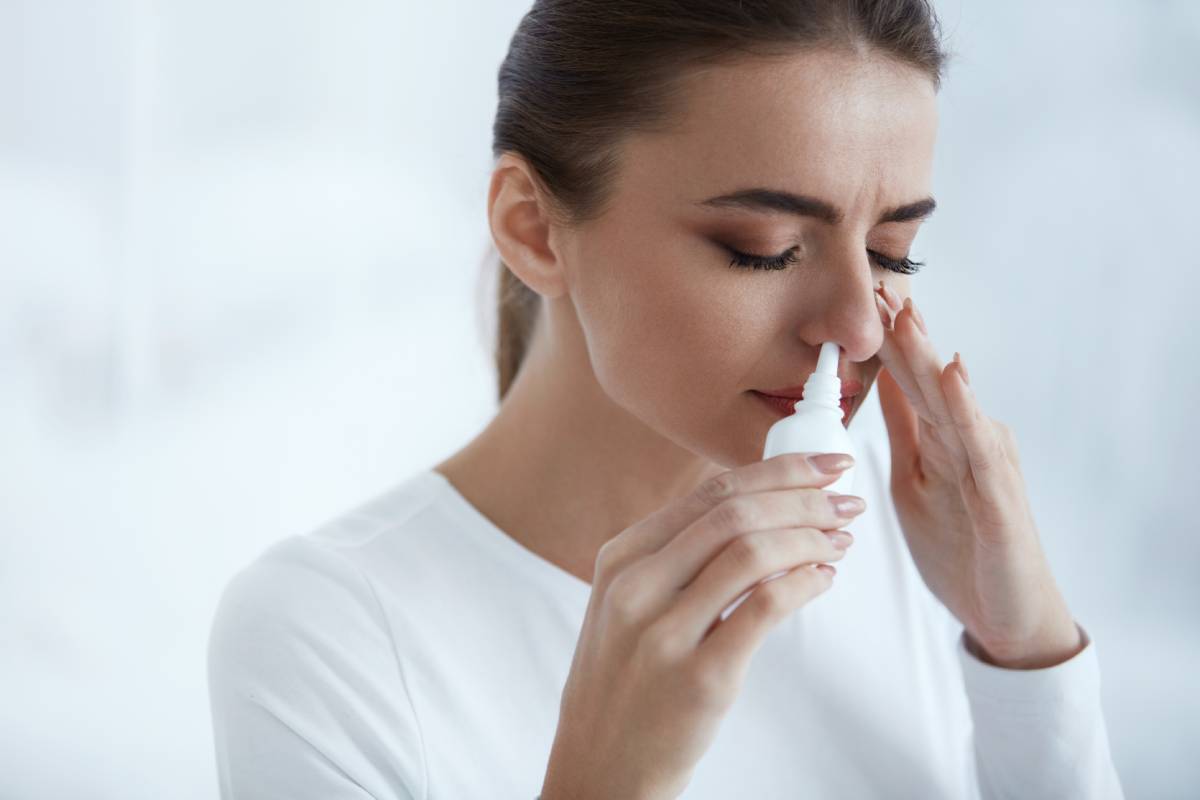Intranasal Steroids and COVID-19

SARS-CoV-2, the virus underlying the Covid-19 pandemic, is known to cause a host of symptoms, including fever, cough, dyspnea, sputum production, myalgia, arthralgia, headache, gastrointestinal issues, rhinorrhea, sore throat, and loss of olfactory ability/taste. Olfactory symptoms are common among Covid-19 patients; in fact, one study found that 86 percent of infected individuals experienced detectable olfactory symptoms.1 Given the prevalence of the virus, it has been of heightened interest to find methods of sino-nasal symptom alleviation. One recently proposed method includes the use of nasal steroids to treat Covid-19.
Nasal steroid sprays are traditionally used to alleviate allergy or, less commonly, non-allergy related inflammation in the nasal cavity. The steroid is suspended within pressurized gas, allowing for dispersion into the nasal cavity upon release from the canister. The effect of the steroid is a reduction in the size of blood vessels and surrounding tissue, therefore treating acute congestion and making respiration easier.
Several studies seem to suggest that chronic use of intranasal steroids can help alleviate some of the olfactory symptoms which characterize Covid-19. A study published by İşlek et al., titled, “Evaluation of effects of chronic nasal steroid use on rhinological symptoms of COVID-19 with SNOT-22 questionnaire,” showed that Covid-19 positive patients who used intranasal mometasone furoate spray once in a day experienced milder olfactory symptoms and had shorter recovery times when it came to post-viral olfactory dysfunction.2 Notably, symptoms were not prevented, merely alleviated. However, another slightly contradictory study found that anosmia – one of the most prevalent and characteristic symptoms of Covid-19 – was not alleviated in patients who self-administered intranasal steroids daily for three weeks.3 Alternatively, some researchers have hypothesized that nasal steroids could be used in the fight against Covid-19 infection itself, as opposed to merely the symptoms. It has been shown that SARS-CoV-2 utilizes the host cell’s ACE2 receptor as a point of entry and adhesion.4 Given their vital role in regulating blood pressure, wound healing, and inflammation, ACE2 receptors can be found in most cell types throughout the body; however, they are expressed in particularly high levels in epithelial tissue and nasal mucosa.5 In fact, studies have shown that higher viral load of SARS-CoV-2 can be found in nasal swabs as compared to throat swabs, a difference which has been attributed to higher levels of ACE2 expression in the nasal mucosa.6 Conversely, research has demonstrated that ACE2 expression in nasal epithelial cells in vitro is significantly suppressed by dexamethasone.5 Taken together, these findings point towards the possibility that corticosteroids could prevent viral infection and replication in nasal epithelial cells by reducing potential entry points into cells. However, transmission is possible through a number of different avenues, so any protection conferred by nasal corticosteroids would be inherently limited.
In conclusion, the use of nasal corticosteroids is a promising approach for the treatment of Covid-19 nasal symptoms, particularly congestion. However, more remains to be learned as to whether there is a possibility of infection prevention, and the literature on anosmia remains inconsistent. We will likely continue to learn more about intranasal corticosteroids and Covid-19 throughout the course of the pandemic.
References
1 Lechien, J. R., Chiesa-Estomba, C. M., De Siati, D. R., Horoi, M., Le Bon, S. D., Rodriguez, A., Dequanter, D., Blecic, S., El Afia, F., Distinguin, L., Chekkoury-Idrissi, Y., Hans, S., Delgado, I. L., Calvo-Henriquez, C., Lavigne, P., Falanga, C., Barillari, M. R., Cammaroto, G., Khalife, M., Leich, P., … Saussez, S. (2020). Olfactory and gustatory dysfunctions as a clinical presentation of mild-to-moderate forms of the coronavirus disease (COVID-19): a multicenter European study. European archives of Oto-rhino-laryngology, 277(8), 2251–2261. https://doi.org/10.1007/s00405-020-05965-1
2 İşlek, A., & Balcı, M. K. (2021). Evaluation of effects of chronic nasal steroid use on rhinological symptoms of COVID-19 with SNOT-22 questionnaire. Pharmacological Reports, 73(3), 781–785. https://doi.org/10.1007/s43440-021-00235-1
3 Abdelalim, A. A., Mohamady, A. A., Elsayed, R. A., Elawady, M. A., & Ghallab, A. F. (2021). Corticosteroid nasal spray for recovery of smell sensation in COVID-19 patients: A randomized controlled trial. American Journal of Otolaryngology, 42(2), 102884. https://doi.org/10.1016/j.amjoto.2020.102884
4 Hoffmann, M., Kleine-Weber, H., Schroeder, S., Krüger, N., Herrler, T., Erichsen, S., Schiergens, T. S., Herrler, G., Wu, N. H., Nitsche, A., Müller, M. A., Drosten, C., & Pöhlmann, S. (2020). SARS-CoV-2 Cell Entry Depends on ACE2 and TMPRSS2 and Is Blocked by a Clinically Proven Protease Inhibitor. Cell, 181(2), 271–280.e8. https://doi.org/10.1016/j.cell.2020.02.052
5 Saheb Sharif-Askari, F., Saheb Sharif-Askari, N., Goel, S., Fakhri, S., Al-Muhsen, S., Hamid, Q., & Halwani, R. (2020). Are patients with chronic rhinosinusitis with nasal polyps at a decreased risk of COVID-19 infection?. International Forum of Allergy & Rhinology, 10(10), 1182–1185. https://doi.org/10.1002/alr.22672
6 Zou, L., Ruan, F., Huang, M., Liang, L., Huang, H., Hong, Z., Yu, J., Kang, M., Song, Y., Xia, J., Guo, Q., Song, T., He, J., Yen, H. L., Peiris, M., & Wu, J. (2020). SARS-CoV-2 Viral Load in Upper Respiratory Specimens of Infected Patients. The New England Journal of Medicine, 382(12), 1177–1179. https://doi.org/10.1056/NEJMc2001737